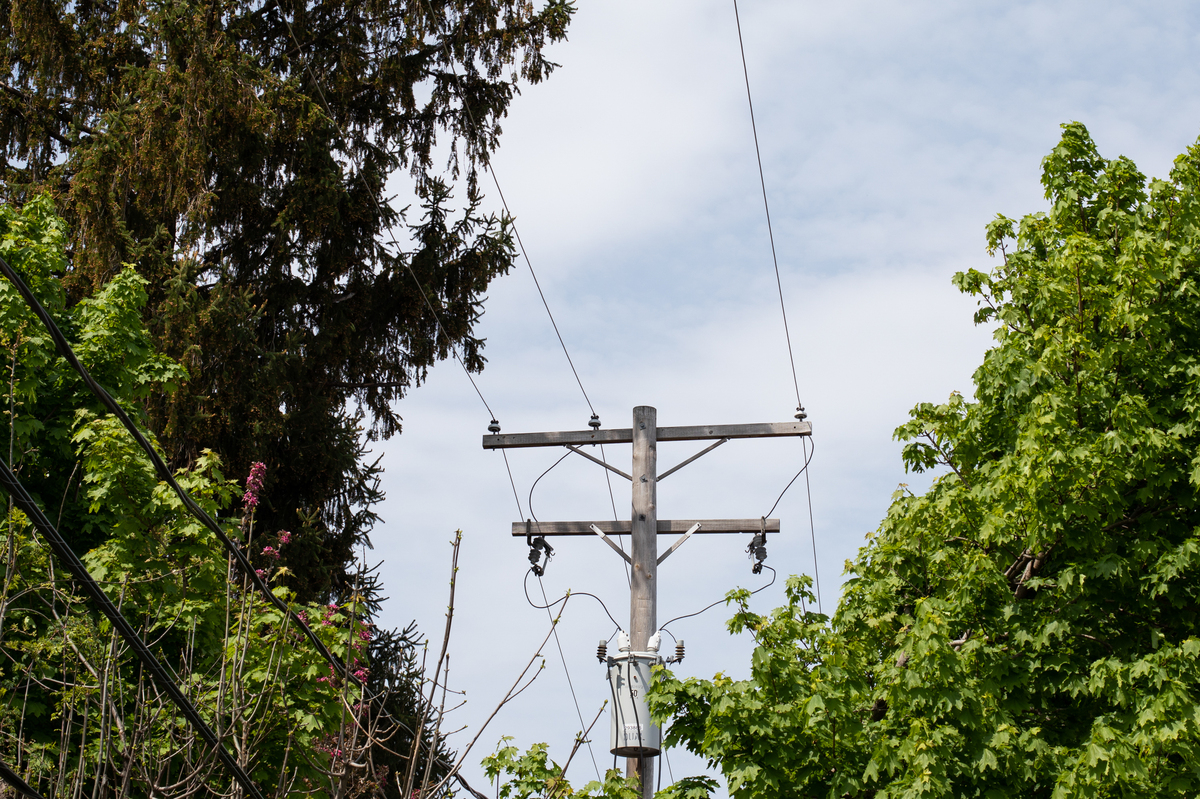Climate Change Is Killing Trees And Causing Power Outages

Enlarge this image
A spiral of dead bark hangs off a sickened acacia branch. The tree was weakened by California’s climate change fueled drought and an opportunistic fungi. «If you can see the wood underneath, which in this case you can, that’s typically a sign that that part of the tree is dead,» says Igor Lacan,» Which is why we didn’t stand under that branch.»
Julia Simon for NPR
hide caption
toggle caption
Julia Simon for NPR

Igor Lacan stands near a dying acacia tree on a hill in Oakland. Lacan is horticulture advisor for the University of California Cooperative Extension and part of his job involves advising utilities like PG&E how to spot sick trees that are at risk of toppling onto power lines.
Julia Simon for NPR
hide caption
toggle caption
Julia Simon for NPR
«If you can see the wood underneath, which in this case you can, that’s typically a sign that that part of the tree is dead. Which is why we didn’t stand under that branch.»
According to researchers at UC Berkeley, opportunistic fungi are killing these trees. California’s climate change-fueled drought, which has persisted for the better part of two decades, has stressed the trees and made them vulnerable to parasites.
Lacan says of the local acacias, «We have never seen the sort of mass mortality that we’re seeing now.»
Climate change has stoked a host of threats to trees, not just in California but across the country. Extreme storms, droughts, disease and insects are stressing and killing trees, and these trees pose a growing threat of wildfires and to grid reliability, many large utilities say. The Dixie Fire in northern California, which has already burned more than 950,000 acres, was likely sparked by a tree falling onto a power line.
According to more than a dozen of the country’s largest utilities, branches and trees falling on power lines are a leading source of power outages. Some utilities say that because of factors related to climate change, trees are dying faster than they can reach them on their normal trimming cycles.
Outages caused by falling vegetation go beyond inconvenience for customers, says Tremaine Phillips, commissioner on the Michigan Public Service Commission. «We know that there are individuals who rely on medical equipment, and that equipment requires electricity. We know that there are families who have medications that need to be kept refrigerated,» he says, «So these impacts are real and for certain families, very acute and potentially dire.»

Left; Researchers at UC Berkeley say that a fungus is killing this acacia tree. The eye-shaped hole is a canker, a sign of the fungi’s presence. Right; Igor Lacan shows the yellowed phyllodes of a dying acacia. California’s climate change-fueled drought weakened the trees and made them vulnerable to parasites.
Julia Simon for NPR
hide caption
toggle caption
Julia Simon for NPR
Climate change make trees more likely to fall
Nina Bassuk, professor of urban horticulture at Cornell University, explains that climate change can kill tree cells through a confluence of stressors. «It’s not like an animal which dies when you pierce the heart — trees die cell by cell,» she says.
Shorter and warmer winters can allow insects and diseases to proliferate, she says. Fluctuating temperatures, heatwaves and drought can disrupt growth or health.
«So if you have a bunch of cells that are dead, a branch, for instance, that will be more apt to fall,» she says.
In 2020, Tropical Storm Isaias left 1.2 million Connecticut residents without power for a week in the middle of a summer heatwave. The state’s Public Service Commission recently fined the state’s largest utility, Eversource, the maximum $28.5 million dollars for failing to prepare and respond to that storm.
Diego Cerrai is professor of engineering at University of Connecticut, and he’s been working with Eversource to study why the outages occurred.
«That storm created many more outages than what was expected by anyone,» says Cerrai, who manages the Eversource Energy Center. «We started investigating why. And one of the reasons was that there was a severe drought over the past two years in this area of the United States, and trees were weaker and more likely to fail.»
Connecticut’s drought, severe storms and winds have weakened trees’ defenses, says Sean Redding, the vegetation manager for Eversource Connecticut. That makes trees vulnerable to insects like gypsy moths, emerald ash borer and hemlock woolly adelgid, and diseases like root rot. Now, those dead trees and their branches are falling on power lines.
«When you have that amount of trees succumbing to these bugs and resulting in mortality, you have a large impact to customers,» Redding says, «Because of the cumulative effect of climate change, insect infestation and disease on our forests here in Connecticut, more trees came down, resulting in more outages.»
Redding says these days when it comes to dead trees, «There are more of them than we can manage in a timely manner.»

Enlarge this image
Igor Lacan points to an eye-shaped hole in the acacia trunk. «Sort of a wound that doesn’t heal,» Lacan says, «That’s a good indication there’s something going on.»
Julia Simon for NPR
hide caption
toggle caption
Julia Simon for NPR

Enlarge this image
This fir tree lies on a power line in the area near the start of the Dixie fire, currently the largest fire in the state. PG&E says the costs of maintaining trees near power lines are part of the reason the utility is moving to bury 10,000 miles of new power lines at a cost of at least $15 billion dollars.
PG&E
hide caption
toggle caption
PG&E

Enlarge this image
A patchwork of national and state regulations require utilities to trim around their power lines. More than a dozen of the country’s largest utilities told NPR that falling trees and branches represent a leading cause of outages.
Ryan Kellman/NPR
hide caption
toggle caption
Ryan Kellman/NPR
A patchwork of national and state regulations require utilities to trim around their power lines. More than a dozen of the country’s largest utilities told NPR that falling trees and branches represent a leading cause of outages.
Ryan Kellman/NPR
Utilities help fuel the climate change now affecting them
Daniel Tait of the Energy and Policy Institute, a utility watchdog group, says it’s important to remember the context for why utilities are now having to adapt vegetation management programs to the changing climate.
«Utilities are now seeing the impacts of climate change, but the big thing is that utilities have fueled climate change for decades,» he says, pointing out that 60 percent of US electricity comes from fossil fuels, whose emissions heat up the planet.
Tait says some of the same utilities grappling with tree mortality related to climate change still invest in new fossil fuel infrastructure. DTE Energy, for example, is currently building a new natural gas plant. «They share culpability for the fact that trees are dying,» Tait says.
DTE Energy says in an email that the new gas plant has about 70% less carbon emissions than the coal plants it’s replacing, and that they will «bring on more renewables.» DTE Energy produces more than two thirds of its electricity from coal and gas.
As climate change leads to more tree mortality and more blackouts, horticulturalists like Igor Lacan say the solution isn’t to plant fewer trees. It’s to plant different trees that can better endure drought and a hotter climate. Plus, shorter trees, he adds. «There are a number of short tree species that work quite well under those distribution lines.»
Looking out at the Oakland hills, Lacan says planting trees is a long-term decision. «What you see here before you is a result of someone’s decision 50 years ago,» he says, «So I think we should be planting more trees and the right trees, the trees that are more able to withstand some of these stresses.»













Комментарии 0